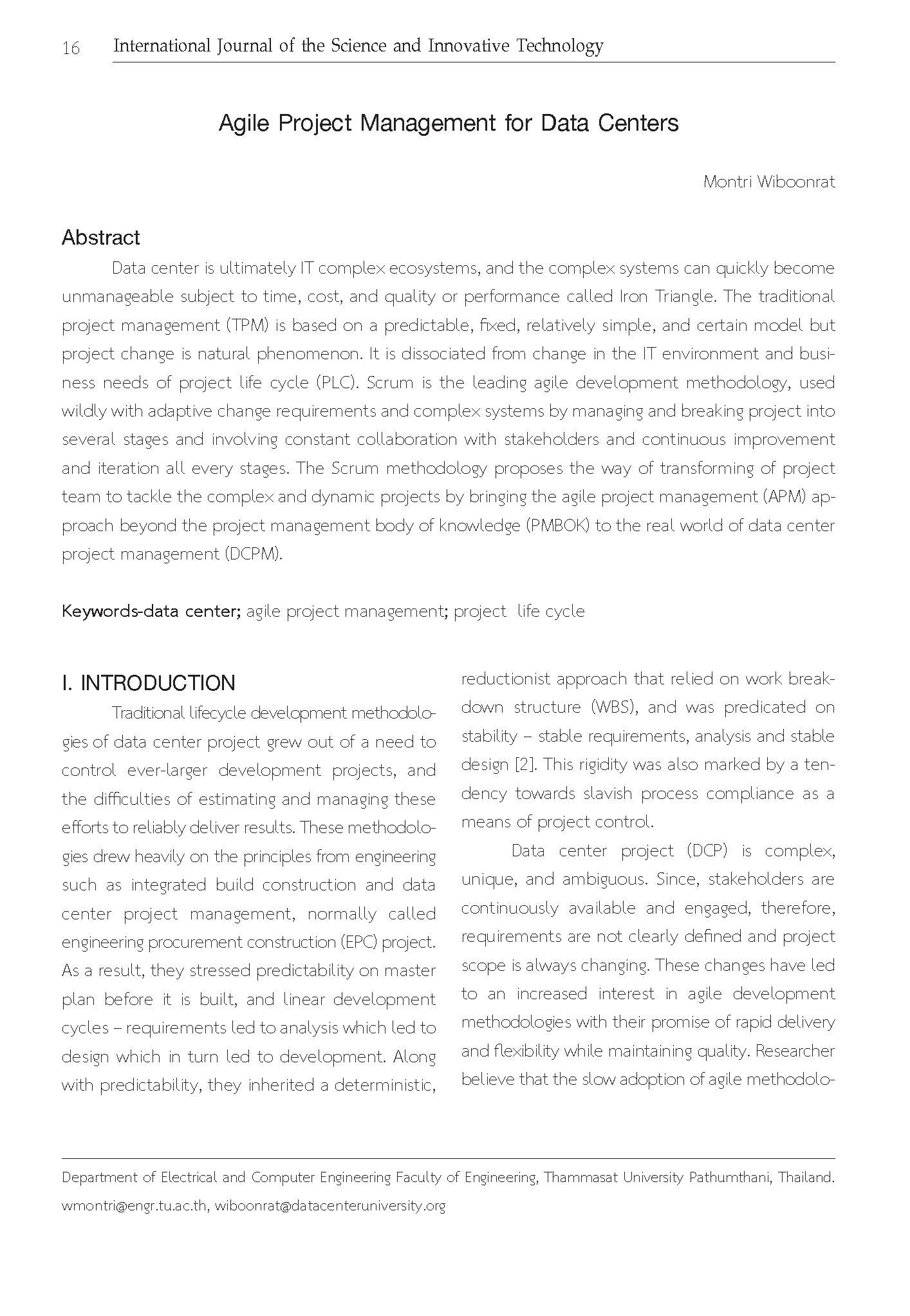- Agile Project Management for Data Centers -
Main Article Content
Abstract
Data center is ultimately IT complex ecosystems, and the complex systems can quickly become
unmanageable subject to time, cost, and quality or performance called Iron Triangle. The traditional
project management (TPM) is based on a predictable, fixed, relatively simple, and certain model but
project change is natural phenomenon. It is dissociated from change in the IT environment and business
needs of project life cycle (PLC). Scrum is the leading agile development methodology, used
wildly with adaptive change requirements and complex systems by managing and breaking project into
several stages and involving constant collaboration with stakeholders and continuous improvement
and iteration all every stages. The Scrum methodology proposes the way of transforming of project
team to tackle the complex and dynamic projects by bringing the agile project management (APM) approach
beyond the project management body of knowledge (PMBOK) to the real world of data center
project management (DCPM).
Article Details
References
across the project life cycle,” Project Management
Journal, 19(3), 1998, pp.67-75.
2. D. Baccarini, “The Logical Framework Method for
Defining Project Success,” Project Management
Journal, vol.30, no.4, 1999, pp.25-32.
3. BICSI-002, Data Center Design and Implementation
Best Practices, BICSI 002-2014, December 9, 2014.
4. Uptime, Uptime Institute, Inc. Tier Classification
Define Site Infrastructure Performance, 2014,
www.upsite.com/whitepapers.
5. TIA-942, Telecommunication Infrastructure Standard
for Data Centers, ANSI/TIA, March, 2014.
6. ASHRAE, Datacom Equipment Power Trends and
Cooling Application, 2nd Edition, 2012.
7. ASHRAE TC 9.9, Data Center Networking Equipment
– Issues and Best Practices, June 24, 2014.
8. IEEE Std. 493-2007, (Revision of IEEE 493-1997),
Recommended Practice for Design of Reliable
Industrial and Commercial Power System, Gold
Book. February 7, 2007.
9. IEEE 1490, IEEE Guide- Adoption of the Project
Management Institute (PMI (R)) Standard A Guid
ot the Project Management Body of Knowledge
(PMBOK(R) Guide) – Fourth Edition, 2011.
10. H. Kerzner, Project Management: A Systems
Approach to Planning, Scheduling, and Controlling,
John Wiley & Sons, Inc., 11 Edition, 2013.
11. A. J. Shenhar and D. Dvir, Reinventing Project
Management: The diamond appraoch to successful
growth and innovation, Harvard Business School Press, 2007.
12. PMBOK, A guide to the project management
body of konwledge, Fifth Edition, PMI, 2013.
13. M. Wiboonrat, “A chronological transformation
of data center project management,” IEEE World
Automation Congress (WAC), 2014, pp. 173-178.
14. M. Wiboonrat, “Systems Engineering Approach
to Final Design Freeze in Uncertain Project Environments,”
2015 19th IEEE International Conference
on Computer Supported Cooperative Work in
Design (CSCWD 2015), May 6-8, 2015. pp. 516-522.
15. APM, The Practical Adoption of Agile Methodologies,
Association for Project Management, May, 2015.
16. M. Wiboonrat, “Engineering changes to improve
the governance in data center proejct management,”
The 9th Annual IEEE International Systems
Conference (SysCon), 2015, pp. 90-95.
17. P. Michael, Enhancing the Quality and Credibility
of Qualitative Analysis, HRS: Health Service Research
34:5 Part II, December, 1999.
18. J. Michael, Scrum Reference Card, 2012, Scrum-
ReferenceCard.com
19. M. Ceschi, et al., “Project management in plan-based
and agile companies,” IEEE Software, May/June
2005, pp. 21-27.


